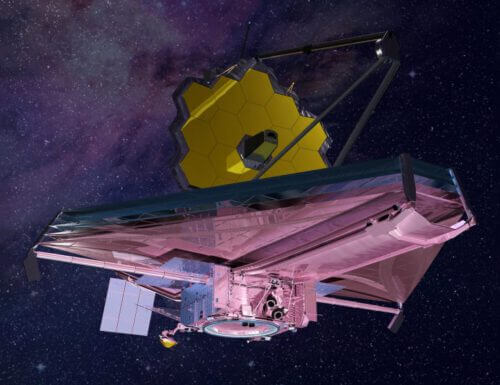Researchers will use the planned space telescope to observe distant asteroids, some of them with moons, to add to and learn about the formation of our solar system and its history
By: Space Telescope Science Institute, May 21, 2020, translation: Ziv Adaki

Millions of asteroids roam our solar system. Many are clustered between Mars and Jupiter, in the main asteroid belt, and many others make up another group, known as Trojan asteroids, that both lead and trail Jupiter. What can these lumps of rock, which are speeding through our solar system as if they were a racing car, tell us about the formation of this planetary system? Research soon to begin using NASA's James Webb Space Telescope, and led by Andrew S. Rivkin of the Applied Physics Laboratory at Johns Hopkins University, will yield new information that will help astronomers begin to solve these mysteries.

"What's wonderful about asteroids is that they are so numerous," says Rivkin. "The meaning is that there will always be an object bright enough in exactly the right place, so that Webb can observe it."
Rivkin's partners are Christina A. Thomas of Northern Arizona University, Stefanie N. Milam of NASA's Goddard Space Flight Center, and Heidi Hammel, a planetary astronomer and vice president of the Association of Universities for Research Astronomy (AURA) in Washington, DC, together they will observe these asteroids in infrared light in the near and medium range.
This team's work will add many new observations to the growing body of research dealing with asteroids, and will help them enrich knowledge about the origins and formation of asteroids, information that will provide clues to the history of the motion of planets in the young solar system.
The beginning of the solar system
Imagine our solar system as it formed 4.6 billion years ago: around the young sun, a disc of gas and dust swirling, condensing to a seal and forming small objects. As larger bodies, such as Jupiter and Saturn, began to form, they gathered clumps of gas and grew larger and larger. Soon, the effect of the gravity of these large bodies began to carve into the board and create gaps in it.
NASA's James Webb Space Telescope. Credit: Conceptual Image Lab at NASA's Goddard Space Flight Center
For millions of years, the theory held that Jupiter, Saturn, Uranus and Neptune began to move from the place where they were originally formed to where they are today, continued to shape the center of the solar system, and eventually locked in fixed orbits rocky remnants between Mars and Jupiter. As Jupiter moved inward, it set these small objects in constant motion, making it difficult for them to unite with each other into larger bodies such as planets.
These rocky messy remnants are asteroids. Today, scientists know that asteroids were the "building blocks" of the rocky inner planets. Some asteroids were formed closer to the Sun and others further away, thus their composition is very diverse. One of the intriguing things that researchers have already learned about asteroids is that many of them may not have formed in the orbits they now orbit.

The Starry Rocks
The research group plans to examine five known asteroids, three in the main asteroid belt and two Trojan asteroids (asteroids that share their orbit with Jupiter), using near- and mid-infrared wavelengths to extend and complement other NASA observational missions and test the new methods using the Web.
They will observe these asteroids, among other things, using the Webb Near Field Infrared Spectrograph, a tool that separates light into its component colors to create a spectrum, which the researchers will analyze to learn about the composition of each object.
One of the main targets in the main asteroid belt is a dwarf planet known as Ceres, which NASA's Dawn probe visited in 2015-2018. On the surface of Kress are minerals containing ammonia, leading researchers to wonder if it formed further out in the solar system or if the dwarf planet merged with material from a more distant source. Webb's measurements at wavelengths longer than those provided by the Dawn probe will provide unique and complete data, and these can be used by the team to examine whether the previous conclusions regarding the vehicle on the surface of Keres are indeed correct. At the same time, the observations will help create a method of observing targets that may be a little too bright to observe at these wavelengths using a web. "We will make the best of this bright object study to open the door to new scientific opportunities that other researchers can conduct using the Web," says Milam.
Ceres is a dwarf planet in the main asteroid belt, between Mars and Jupiter. In 2021, after the James Webb Telescope is launched into space, it will help researchers learn more about the formation of the Solar System by observing objects such as the Hook using Webb's powerful infrared capabilities. Credit: NASA Visualization Technology Applications and Development
Pallas, the second largest asteroid in the main asteroid belt, a dwarf planet candidate, is another important target. Due to its orbit, it would be difficult for a spacecraft to visit Pallas. Viewing it through the web will allow the team to collect data on its surface and composition, data that would be difficult to obtain in any other way. The team will also compare the measurements of Pallas and another asteroid, Hygeia, also a dwarf planet candidate, with data on Ceres; The comparison will help the researchers to identify the similarities and differences in these goals. These comparisons may offer clues about the formation history of these building blocks of the inner planets.
The Trojan targets, Patroclus and Hektor, are very different from other asteroids that Webb will observe - not only because of their proximity to Jupiter, but because these targets have moons. Hector is a binary asteroid, and its moon moves in a close orbit. On the other hand, between Patroclus and his moon the space is larger. "Web will allow us to study each of the asteroids and their moons individually," explains Rivkin. "By studying the moons, we will also be able to examine how each of these binary asteroids formed and compare the two systems." The data will also help astronomers calibrate models describing how Trojan asteroids were caught in their current orbits.
Illustration of clusters of asteroids in the solar system. The central asteroid belt stretches between Mars and Jupiter, and the Trojan asteroids both lead and trail Jupiter. Researchers now know that asteroids were the "building blocks" of the inner planets. Those that remain are airless rocks that failed to stick together and become larger bodies, during the formation of the solar system 4.6 billion years ago. Credit: NASA, European Space Agency and J. Olmsted (STScI)
Data for the entire planetary science community
The team carefully selected its targets for the program, ensuring that the data produced would extend the data of current and future missions and observations. "Patroclus, for example, is the target of a future NASA mission called Lucy," says Thomas. "We will be able to compare Webb's data with previous data, which originate from observations from the ground. There will be a lot of additional data to examine.”
By uncovering the histories of these particular asteroids, the research team hopes to learn more about the past of our solar system. They emphasize that Webb provides a unique opportunity, not only because of its expertise in infrared light, but also because some of these targets are very difficult to observe with other facilities. "The Web allows us to 'visit' many more asteroids with high-quality observations that we cannot achieve with ground-based telescopes," says Rivkin.
The observatory also offers new research opportunities. "Web will open a new front for all scientists," explains Milam. "Our data will lead to new questions and spark many new scientific ideas that astronomers considering using the Web in the future can pursue."
This research is part of the Webb Guaranteed Time Observations (GTO) program, which is led by Webb Interdisciplinary Researcher Heidi Amell. Researchers who worked with NASA to create the Web's scientific capabilities during its development were awarded research time in this program.
"The goal of these studies is to make sure that we not only do the best science we can do, but also build the necessary infrastructure for research that will be conducted using the Web in the future," Amal says.
When launched into space in 2021, the James Webb Space Telescope will be the first scientific observatory ever. Webb will solve mysteries in our solar system, observe distant worlds and explore the mysterious structures and origins of our universe and our place within it. WEB is an international mission led by NASA with its partners the European Space Agency and the Canadian Space Agency.
In the same topic on the science website:

One response
drinking on the bear skin..
I hear about the launch of this telescope and every time it gets postponed.
Reminds me of the promise of almost free electricity in a melting pot (maximum another 15 years)